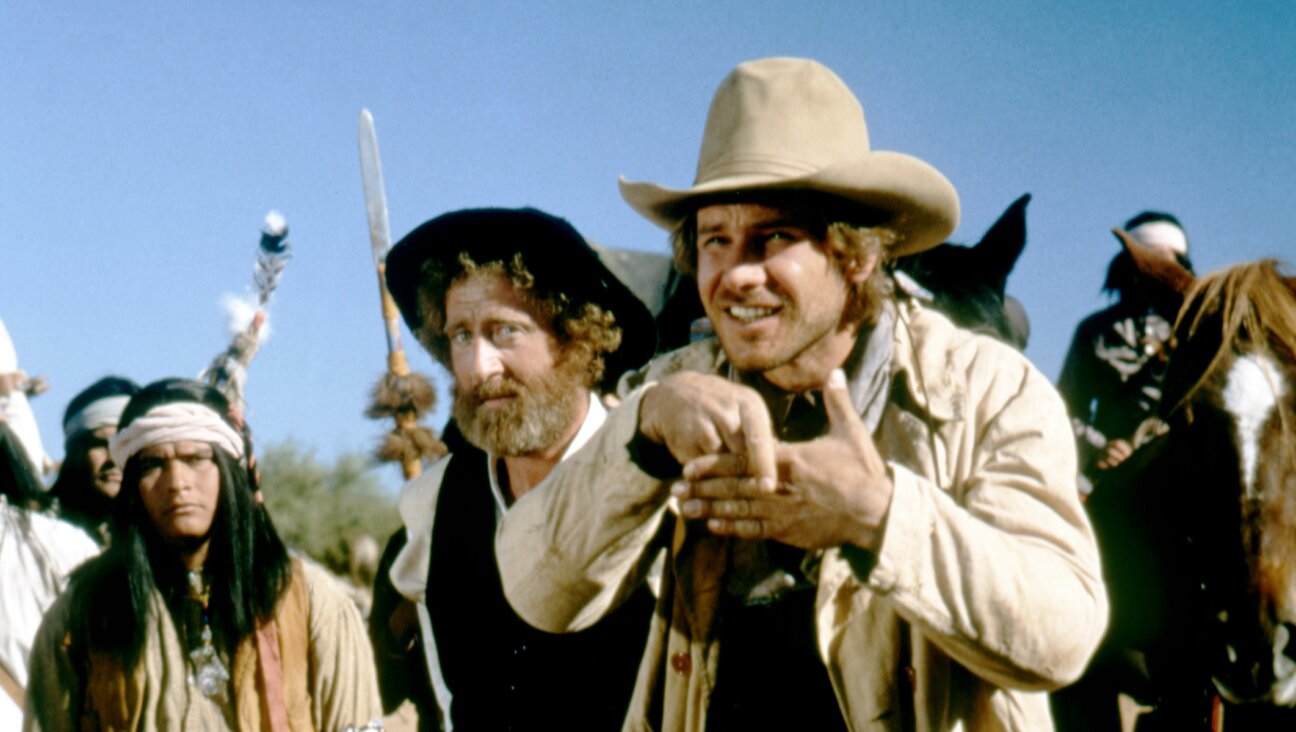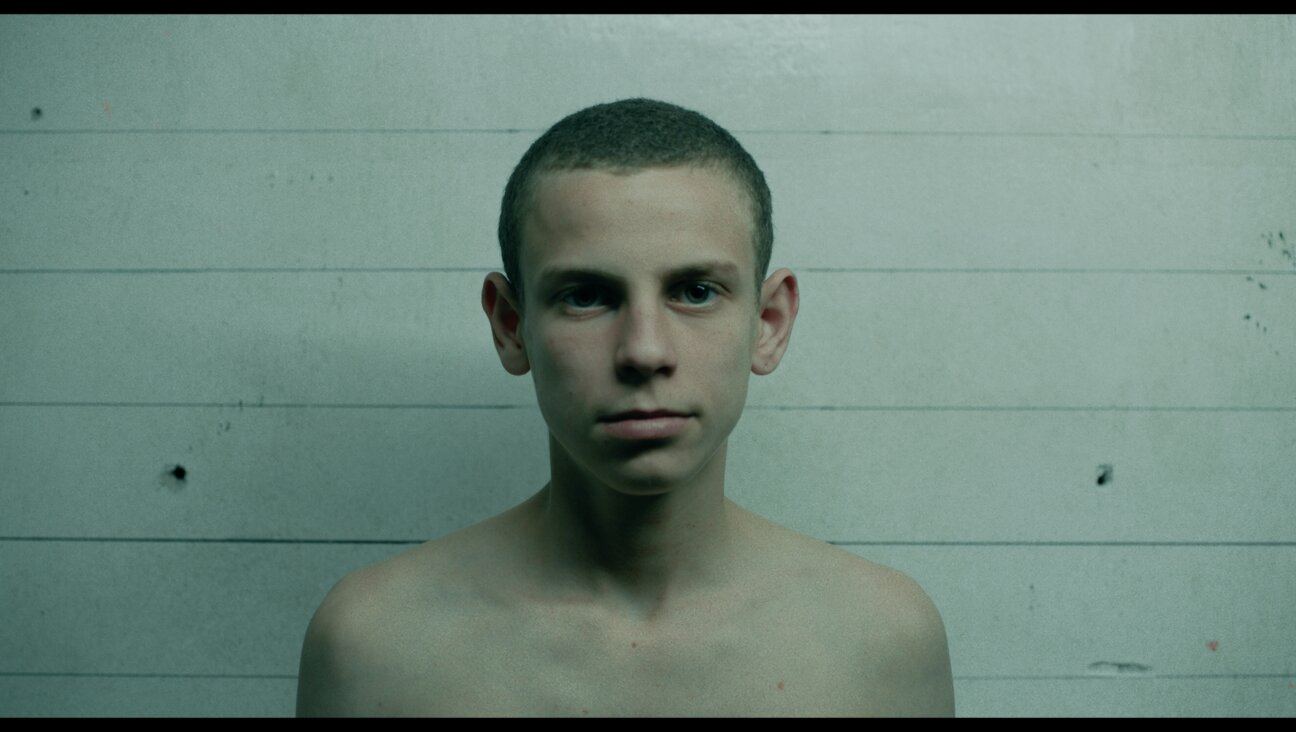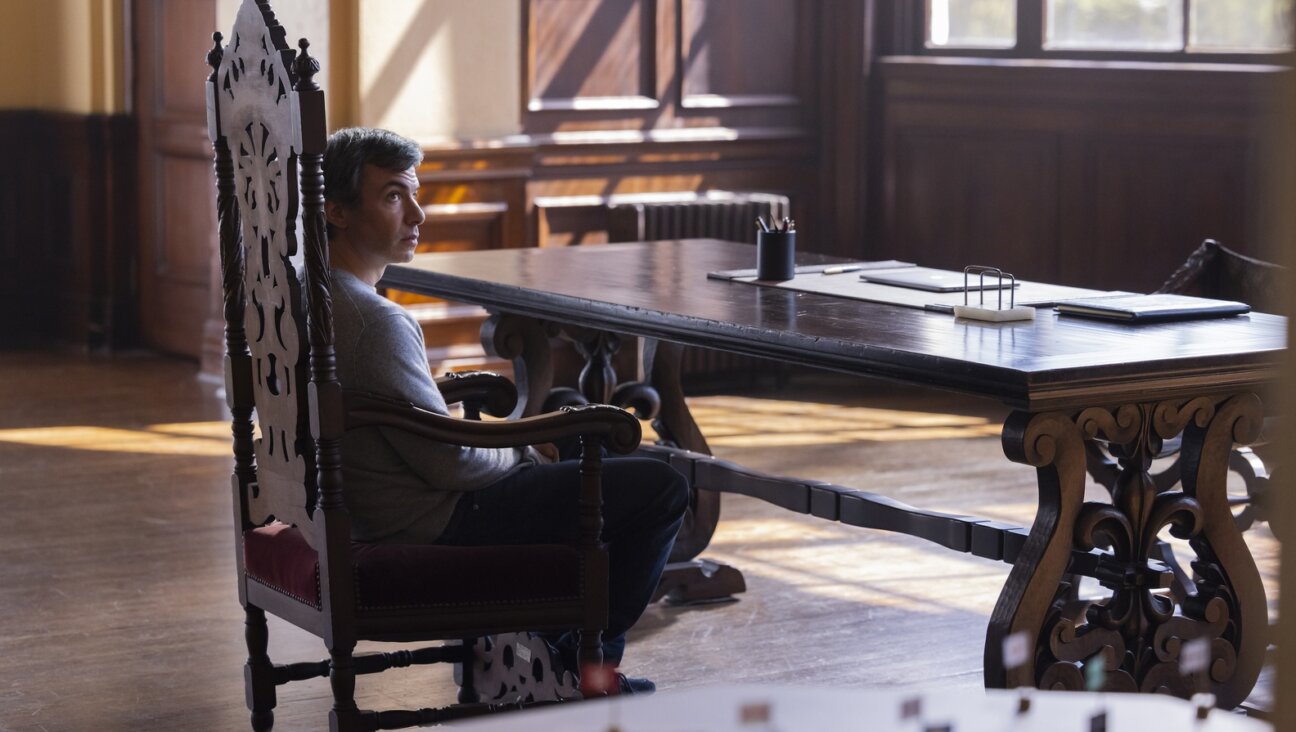Neil Diamond’s blackface scene might be the most embarrassing moment in Jewish cinema history

Neil Diamond By Getty Images
On October 6th 1927, the original film production of “The Jazz Singer” made its world premiere at the Warners’ Theatre in midtown Manhattan. (I know, I know — seems like just yesterday, right?)
Though difficult to sit through these days, even without the segments where Al Jolson appears in blackface, “The Jazz Singer” nevertheless continues to hold an important place in the history of American cinema. Not only was it the first full-length motion picture to feature lip-synchronous singing and dialogue, and a synchronized music score, but “The Jazz Singer” was also the most successful English-language film of the era to tackle the subject of the assimilation of European Jews in America.
In the film, Jolson’s character Jake Robin (born Jakie Rabinowitz) is disowned by his cantor father for singing African-American-influenced music, and runs away from the Jewish ghetto of the Lower East Side to find fame and fortune on Broadway. (The story somewhat mirrors Jolson’s own life: the actor, whose father was a rabbi and cantor, was born Asa Yoelson in the Kovno Governorate of the Russian Empire, and immigrated to the U.S. with his family shortly before his ninth birthday.)
Unfortunately, “The Jazz Singer” also has the distinction of spawning perhaps the most embarrassing entry in the entire history of Jewish-American cinema: the 1980 remake of “The Jazz Singer,” starring Neil Diamond. Though the film does feature three of Diamond’s biggest and best-loved hits (“Love on the Rocks,” “Hello Again” and “America”), it’s basically a proto-Lifetime flick with musical performances, an endeavor undermined by a threadbare plot, limp direction, dopey dialogue and performances that sail wide of the mark in every conceivable manner.
And with the exception of the aforementioned hits, the songs that fill the film (and its accompanying soundtrack album) aren’t exactly top-tier Diamond material; I highly doubt that many fans count the dreary “Songs of Life,” the Jimmy Buffett retread “Acapulco” or the banjo jamboree of “On the Robert E. Lee” among their favorite Neil jams.
Which is not to say that I haven’t spent many, many hours watching and re-watching “The Jazz Singer” — as a longtime aficionado of both Neil Diamond and utterly terrible films, this baby is right in my wheelhouse. Diamond, in his first (and understandably last) dramatic role, plays Jess Robin (born Yussel Rabinovitch), a fifth-generation cantor who leaves his wife (Caitlin Adams), father (none other than Sir Laurence Olivier) and home in New York City to pursue pop stardom in Los Angeles.
Barry Manilow was reportedly considered for the Jess Robin role, and would have at least injected some campy zest into the film; but Diamond, obviously uncomfortable in front of the cameras when he’s not singing, just kind of plows through his scenes with a dull determination that says, “I’d really like to return to my trailer as soon as possible.”
Olivier, on the other hand, chews his dialogue like a dedicated fresser digging into a pastrami on rye at Katz’s Deli; as cringe-inducing screen portrayals of Jews by non-Jewish actors go, Olivier’s is just a prosthetic nose short of surpassing Alec Guinness as Fagin in 1948’s “Oliver Twist.: And then there’s Lucie Arnaz, a last-minute addition to the cast as Molly, Jess’s shiksa love interest. (Deborah Raffin was originally slated to play the part, but bailed out when Arthur Laurents — one of several writers who attempted to fashion the script into something serviceable — kept rewriting her lines during the shoot.)
Arnaz is a pleasant-enough presence in her own right, but the pairing of her with Diamond generates absolutely nothing in the way of romantic sizzle; their shirtless fireside love scene may truly be one of the most agonizingly uncomfortable things I’ve ever watched.
Still, unbelievable as it may seem, that love scene isn’t even the worst moment in “The Jazz Singer,” nor is Olivier’s performance the most excruciating component. That’s because the remake’s original director, Sidney J. Furie, insisted upon having Diamond appear in blackface as a knowing wink to the Al Jolson original. Yes, that’s right — Neil Diamond in blackface.
“I think he thought it was good entertainment,” Stephen Foreman, the remake’s original screenwriter, told author Rich Wiseman in an interview for Wiseman’s 1987 book, “Neil Diamond: Solitary Star.” “But I said, ‘No way am I gonna write that scene. In the first place, it’s racist, in the second place it’s bullshit.’” (Memo to today’s self-appointed warriors against “political correctness”: Yes, blackface was once a standard showbiz convention, but it had long ceased to be so by 1980, when anyone with even the slightest bit of cultural sensitivity was well aware that wearing it was, at the very least, in poor taste.)
Unsurprisingly, Foreman didn’t stick around to finish the project, while the studio eventually replaced Furie with Richard Fleischer after production costs spiraled out of control; but somehow, Diamond’s blackface scene remained in the film. And oy, what a scene it is!
Though employed as a cantor at his father’s synagogue, Jess has secretly been honing his songwriting craft by penning material on the side for the Four Brothers, a soul vocal group that includes his friend Bubba (Franklyn Ajaye). But when one of the Brothers gets arrested and misses the group’s gig at the Cinderella Club, putting their showcase for a big agent in jeopardy, they draft Jess in to deputize for him. Unfortunately, the club appears to have a blacks-only policy: “Please tell me that ain’t no white man,” begs emcee John Witherspoon, when he spies Jess in the dressing room. But the Brothers have a plan: Not only do they have an extra Billy Preston afro wig on hand for Jess, they also just so happen to have some shoe polish…
Looking a lot like Greg Brady in “A Very Offensive Brady Christmas” the newly blackfaced and be-afroed Jess takes the stage, delivering the lead vocal of his song “You Baby” with the same constipated bray that has characterized every Diamond attempt to really get down since his ill-advised 1966 cover of “La Bamba.”
But despite these obvious liabilities, and the fact that the song itself sounds like a third-rate Spinners outtake played back at slightly the wrong speed, the all-Black crowd at the Cinderella Club can’t seem to get enough of Jess’s funky stuff. They’re feeling it, hooting and hollering and carrying on in time to the music — and when the song ends, they fall all over themselves to give the group a standing ovation. Jess nods and grins in gratitude, his giddy expression a mixture of “Wow, we fooled them!” and “These people sure know a true soul singer when they hear one!”
Unfortunately, one particularly perceptive audience member notices that the hands Jess has been clapping with don’t actually match the color of his face. “No, no, no, everybody!” he shouts above the applause. “That ain’t no brother — that’s a white boy!” “NO!” the rest of the crowd responds in sheer disbelief, as if they cannot conceive of Jess being anything other than the real deal, especially after that mind-blowing performance.
The unhappy patron strides purposefully to the stage, intent on having a word with Jess — probably something along the lines of how massively disrespectful and/or deeply fucked-up it is for a white person to take the stage in blackface, especially in front of a Black audience. Bubba tries to step between them, but the patron pushes him aside; whereupon Jess, rather than profusely apologizing or beating a hasty retreat from the club (both of which would have been legitimate options under the circumstances), hauls off and decks the guy.
The club instantly explodes into a full-scale brawl, and the gig ends even more quickly and chaotically than that infamous 1986 show at NYC’s Cat Club where GG Allin took the stage with the announcement that he’d ingested “twice as much Ex-Lax as usual.”
Somebody calls the cops, and Jess and the Brothers are promptly hauled off to jail — which is probably not the best place for a white guy to show up wearing blackface, but Jess somehow manages to stay alive until morning, when his father comes to bail them out. Cantor Rabinovitch is deeply disappointed in his son, but maybe not for the same reasons we are. Staring daggers at Jess’s shoe polish-stained face, he sneers, “Eets not taff enaff… beink a CHEW?”
Nearly forty years later, it still boggles my mind that any of this made the film’s final cut. It’s also kind of surprising that Diamond’s career didn’t suffer any real blowback as a result. Sure, he was justifiably awarded that year’s Golden Raspberry for Worst Actor (Olivier won Worst Supporting Actor), and the film received a ton of negative reviews, but there was precious little discussion (or even mention) in the press about Diamond’s blackface performance. Perhaps that’s because the scene is played for laughs, a la Gene Wilder’s blackface turn in 1976’s “Silver Streak” — or because (also as in “Silver Streak”) the white character has donned blackface reluctantly, and only at a Black character’s behest.
Or maybe it’s just that nobody at the time took Diamond (or the film) seriously enough to be offended by it. Just a year earlier, Elvis Costello — an artist with a significantly lower commercial profile — made headlines and received numerous death threats after drunkenly attempting to provoke some American musicians into a bar fight by using the N-word to describe James Brown and Ray Charles.
But Diamond was no edgy provocateur; by 1980, he’d already achieved an incredible run of hits and had established himself as one of the country’s biggest concert draws, and was settling firmly into the family-friendly “Jewish Elvis” mode that he would occupy for the rest of his career. Nothing he’d done before (or would do again) pointed to any real racial bias or maliciousness, so perhaps everyone just wrote it off as mere cluelessness on his part and moved on.
Still, one wonders what Diamond himself thought of the scene, especially in light of what another major Jewish music icon was up to at the time. In early 1980, while “The Jazz Singer” was being filmed, Bob Dylan was in the midst of his “Gospel Tour,” singing songs that reflected his newfound embrace of Christianity. Though the tour — which featured setlists primarily drawn from “Slow Train Coming” and “Saved,” along with the occasional between-song Dylan sermon — was lambasted by fans and critics alike, Dylan’s band included a number of extremely talented Black vocalists, including Helena Springs, Carolyn Dennis, Clydie King and Regina Havis, the latter of whom would typically open the evenings with a selection of traditional gospel songs. However controversial, Dylan’s shows at least offered a respectful showcase for Black music and talent, while Diamond was busy playing “Black music” as a gag.
In any case, Neil Diamond’s brief foray into blackface remains the weirdest and most “Seriously, WTF?” moment of an otherwise-dazzling career that has stretched nearly six decades. That it also remains the most memorable and interesting part of “The Jazz Singer” remake is just more evidence that Jolson’s original didn’t need a reboot. Not that Diamond would likely argue that point: “I read all the reviews and laughed,” he said of his film in 1986. “It was either that or shoot myself.”
Dan Epstein is the Forward’s contributing music critic.
The Forward is free to read, but it isn’t free to produce

I hope you appreciated this article. Before you go, I’d like to ask you to please support the Forward.
Now more than ever, American Jews need independent news they can trust, with reporting driven by truth, not ideology. We serve you, not any ideological agenda.
At a time when other newsrooms are closing or cutting back, the Forward has removed its paywall and invested additional resources to report on the ground from Israel and around the U.S. on the impact of the war, rising antisemitism and polarized discourse.
This is a great time to support independent Jewish journalism you rely on. Make a gift today!
— Rachel Fishman Feddersen, Publisher and CEO
Support our mission to tell the Jewish story fully and fairly.
Most Popular
- 1

Culture Cardinals are Catholic, not Jewish — so why do they all wear yarmulkes?
- 2

News School Israel trip turns ‘terrifying’ for LA students attacked by Israeli teens
- 3

Fast Forward Ye debuts ‘Heil Hitler’ music video that includes a sample of a Hitler speech
- 4

Fast Forward Student suspended for ‘F— the Jews’ video defends himself on antisemitic podcast
In Case You Missed It
-

Yiddish קאָנצערט לכּבֿוד דעם ייִדישן שרײַבער און רעדאַקטאָר באָריס סאַנדלערConcert honoring Yiddish writer and editor Boris Sandler
דער בעל־שׂימחה האָט יאָרן לאַנג געדינט ווי דער רעדאַקטאָר פֿונעם ייִדישן פֿאָרווערטס.
-

Fast Forward Trump’s new pick for surgeon general blames the Nazis for pesticides on our food
-

Fast Forward Jewish feud over Trump escalates with open letter in The New York Times
-

Fast Forward First American pope, Leo XIV, studied under a leader in Jewish-Catholic relations
-
Shop the Forward Store
100% of profits support our journalism
Republish This Story
Please read before republishing
We’re happy to make this story available to republish for free, unless it originated with JTA, Haaretz or another publication (as indicated on the article) and as long as you follow our guidelines.
You must comply with the following:
- Credit the Forward
- Retain our pixel
- Preserve our canonical link in Google search
- Add a noindex tag in Google search
See our full guidelines for more information, and this guide for detail about canonical URLs.
To republish, copy the HTML by clicking on the yellow button to the right; it includes our tracking pixel, all paragraph styles and hyperlinks, the author byline and credit to the Forward. It does not include images; to avoid copyright violations, you must add them manually, following our guidelines. Please email us at [email protected], subject line “republish,” with any questions or to let us know what stories you’re picking up.
















